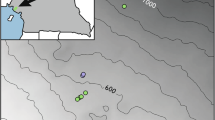Abstract
Visitation rates and mean numbers of visits per flower per day are determined at three altitudinal levels (2 200–3 600 m) in the high Andes of central Chile from quantified observations of flowers visitors to a total of 134 species of plants, studied over three flowering seasons. Significant altitudinal decreases in the mean no. visits/flower/minute and per day were recorded, with Level III flowers, on the average, being pollinated only about 1/2 as frequently and to as low as 1/4 as frequently in certain months, as Level I flowers. Visitation rates are generally highest in early and mid-summer at all altitudes. — The lower visitation rates at the higher elevations are due to lower insect abundance relative to plant resources and lower levels of activity for the insects present, stemming from the generally lower ambient temperatures. Seasonal differences in visitation rates may also be related to differences in insect abundance levels. The total probability of ovule pollination cannot be estimated directly from the pollination rates, because stigmas are probably receptive for longer periods at the higher elevations. When differences in the duration of stigma receptivity are estimated from differences in flower lifelength, the probability of pollination in Level III is not very different from that expected in Level I. However, for some months, the deficit in Level III may still be substantial. — These results underline the inherent dangers of predicting pollination possibilities directly from pollination rates. They also suggest that the impoverished pollination conditions assumed in hypotheses predicting higher amounts of self-compatibility at high altitudes might not be justified for all high temperate mountains.
Similar content being viewed by others
References
Armesto, J. J., Arroyo, M. T. Kalin, Villagrán, C., 1980: Altitudinal variation, cover and size structure of umbelliferous cushion plants in the high Andes of central Chile. — Oecol. Gener.1, 327–332.
Arroyo, Mary T. Kalin, Armesto, J. J., Primack, R., 1983: Tendencias altitudinales y latitudinales en mecanismos de polinización en la zona andina de los Andes templados de Sudamérica. — Revista Chilena de Historia Natural56, 159–180.
—, 1981: Plant phenological patterns in the high Andean cordillera of central Chile. — J. Ecol.69, 205–223.
—, 1982: Community studies in pollination ecology in the high temperate Andes of central Chile. I. Pollination mechanisms and altitudinal variation. — Amer. J. Bot.69, 82–97.
Baker, H. G., 1955: Self-incompatibility and establishment after long-distance dispersal. — Evolution9, 114–143.
Billings, W. D., 1974: Arctic and alpine vegetation: plant adaptations to cold summer climates. — InIves, J. D., Barry, R. G., (Eds.): Arctic and Alpine Environments. London: Methuen.
Downes, J. A., 1965: Adaptations of insects in the Arctic — Ann. Rev. Entomol.10, 257–274.
Eisikowitch, D., Galil, J., 1971: Effect of wind on the pollination ofPanacratium maritimum (Amaryllidaceae) by hawkmoths (Lepidoptera: Sphingidae). — J. Anim. Ecol.40, 673–678.
Grime, J. P., 1979: Plant Strategies and Vegetation Processes. — New York: John Wiley & Sons.
Heinrich, B., 1974: Thermoregulation in endothermic insects. — Science178, 747–756.
—, 1975: Thermoregulation in bumblebees. II. Energetics of warm-up and free flight. — J. Comp. Physiol.96, 155–166.
—, 1972: Energetics and pollination ecology. — Science176, 597–602.
Lloyd, D. G., 1965: Evolution of self-incompatibility and racial differentiation inLeavenworthia (Cruciferae). — Contr. Gray Herb.195, 3–134.
Mani, M. S., 1962: Introduction to High Altitude Entomology: Insect Life above timberline in the Northwestern Himalayas. — London: Methuen.
Parrish, J. A. D., Bazzaz, F. A., 1979: Difference in pollination niche relationships in early and late successional plant communities. — Ecology60, 597–610.
Primack, R. B., 1978: Variability in New Zealand montane and alpine pollinator assemblages. — New Zealand J. Ecol.1, 66–73.
Rick, C. M., 1966: Some plant-animal relations on the Galápagos Islands. — In: “The Galápagos”. — Proc. Sympos. Galáp. Int. Sci. Proj. Berkeley & Los Angeles: Univ. Calif.
Simpson, B. B., 1979: Quaternary biogeography of the high montane regions of South America. — InDuellman, W. E., (Ed.): The South American Herpetofauna, pp. 157–188. — Mus. Nat. Hist., University of Kansas.
Sobrevila, C., Arroyo, M. T. Kalin, 1982: Breeding systems in a tropical montane could forest in Venezuela. — Plant Syst. Evol.140, 19–37.
Author information
Authors and Affiliations
Additional information
First part of this series:Arroyo & al. (1982).
Rights and permissions
About this article
Cite this article
Arroyo, M.T.K., Armesto, J.J. & Primack, R.B. Community studies in pollination ecology in the high temperate Andes of central Chile II. effect of temperature on visitation rates and pollination possibilities. Pl Syst Evol 149, 187–203 (1985). https://doi.org/10.1007/BF00983305
Received:
Issue Date:
DOI: https://doi.org/10.1007/BF00983305




